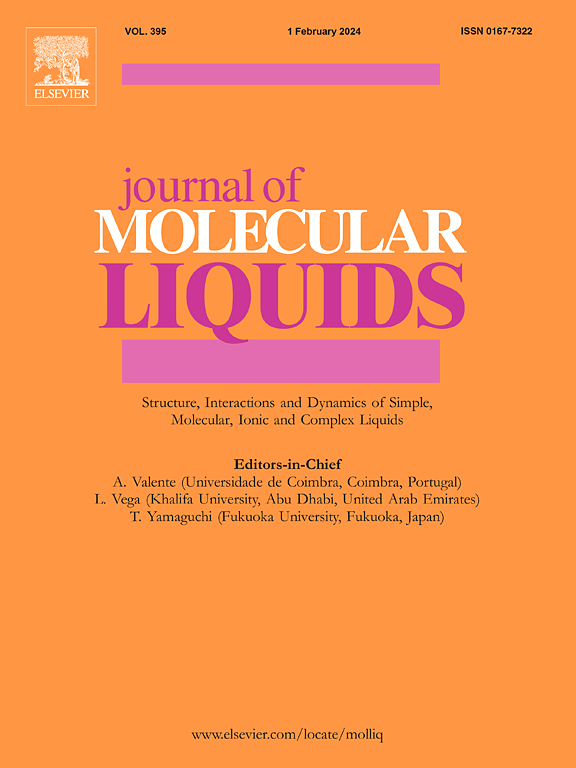阳离子苯磺酰胺表面活性剂的合成及其在甜条件下对碳钢防腐性能的评估:经验和计算研究
IF 5.3
2区 化学
Q2 CHEMISTRY, PHYSICAL
引用次数: 0
摘要
本研究采用简单的两步法合成了三种含有苯磺酰胺分子的阳离子表面活性剂(PSA-8、PSA-10 和 PSA-12)作为缓蚀剂。通过 1H 和 13C NMR 等光谱工具研究了它们的化学结构。研究了制备的阳离子表面活性剂的表面活性。为了评估这些表面活性剂在二氧化碳-3.5% NaCl 环境中保护碳钢管道(C1018-steel)免受腐蚀的效果,研究人员采用了多种技术,包括电化学测量(电位极化(PDP)和电化学阻抗光谱(EIS)技术)、应用 X 射线光电子能谱(XPS)分析的表面形貌检查、密度泛函理论(DFT)计算和蒙特卡罗(MC)模拟。值得注意的是,PSA 表面活性剂的腐蚀效率与之前报道的含有 CN 基团(即电子抽离基团)的阳离子表面活性剂进行了比较。实验结果表明 PSA 表面活性剂具有出色的抑制性能,抑制能力从 92.8% 到 97.0%。这表明除去 CN 基团后,缓蚀效率显著提高,从而揭示了电子效应以及吸附和腐蚀过程。Tafel 数据分析表明,这些表面活性剂是混合型抑制剂,在碳钢界面和腐蚀介质上的吸附遵循 Langmuir 等温线模型。XPS 分析证实在碳钢界面上建立了屏蔽屏障。利用 DFT 计算建立了理论参数与实验观察之间的相关性,从而验证了它们之间的联系。此外,利用 MC 模拟验证了合成表面活性剂在铁(1 1 0)表面的吸附性能。最终,这项研究为开发和配制具有强大抑制作用的生物活性抑制剂提供了重要启示。本文章由计算机程序翻译,如有差异,请以英文原文为准。
Synthesis and evaluation of anticorrosive properties of cationic benzenesulphonamide surfactants on carbon steel under sweet conditions: Empirical and computational investigations
In this study, three cationic surfactants bearing a benzenesulphonamide moiety as corrosion inhibitors (PSA-8, PSA-10, PSA-12) were synthesized using a straightforward two-step process. Their chemical structures were investigated via spectroscopic tools such as 1H and 13C NMR. The surface activity of as-prepared cationic surfactants was examined. To evaluate the effectiveness of these surfactants in the corrosion protection of carbon steel pipelines (C1018-steel) in a CO2-3.5 % NaCl environment, several techniques were used, including electrochemical measurements (potentiodynamic polarization (PDP) and electrochemical impedance spectroscopy (EIS) techniques), surface morphology examinations applying X-ray photoelectron spectroscopy (XPS) analysis, density functional theory (DFT) calculations, and Monte Carlo (MC) simulations. Notably, the corrosion efficiency of the PSA surfactants was compared with previously reported cationic surfactants containing the CN group (i.e., an electron-withdrawing group). The experimental results showed excellent inhibition performance of the PSA surfactants, with inhibition capacities ranging from 92.8 % to 97.0 %. This indicates that removing the CN group has significantly enhanced the corrosion inhibition efficiency, shedding light on the electronic effect as well as the adsorption and corrosion processes. Analysis of the Tafel data indicated that these surfactants functioned as mixed-type inhibitors and followed the Langmuir isotherm model in their adsorption on the carbon steel interface and the corrosive medium. XPS analysis confirmed the establishment of a shielding barrier at the interface of the carbon steel. DFT calculations were employed to establish the correlations between theoretical parameters and experimental observations, thereby validating their connection. Moreover, the employment of MC simulations validated the efficacy of the adsorption properties of the synthesized surfactants on the iron (1 1 0) surface. Ultimately, this investigation provides substantial insights into the development and formulation of bioactive inhibitors characterized by their potent inhibitory effectiveness.
求助全文
通过发布文献求助,成功后即可免费获取论文全文。
去求助
来源期刊

Journal of Molecular Liquids
化学-物理:原子、分子和化学物理
CiteScore
10.30
自引率
16.70%
发文量
2597
审稿时长
78 days
期刊介绍:
The journal includes papers in the following areas:
– Simple organic liquids and mixtures
– Ionic liquids
– Surfactant solutions (including micelles and vesicles) and liquid interfaces
– Colloidal solutions and nanoparticles
– Thermotropic and lyotropic liquid crystals
– Ferrofluids
– Water, aqueous solutions and other hydrogen-bonded liquids
– Lubricants, polymer solutions and melts
– Molten metals and salts
– Phase transitions and critical phenomena in liquids and confined fluids
– Self assembly in complex liquids.– Biomolecules in solution
The emphasis is on the molecular (or microscopic) understanding of particular liquids or liquid systems, especially concerning structure, dynamics and intermolecular forces. The experimental techniques used may include:
– Conventional spectroscopy (mid-IR and far-IR, Raman, NMR, etc.)
– Non-linear optics and time resolved spectroscopy (psec, fsec, asec, ISRS, etc.)
– Light scattering (Rayleigh, Brillouin, PCS, etc.)
– Dielectric relaxation
– X-ray and neutron scattering and diffraction.
Experimental studies, computer simulations (MD or MC) and analytical theory will be considered for publication; papers just reporting experimental results that do not contribute to the understanding of the fundamentals of molecular and ionic liquids will not be accepted. Only papers of a non-routine nature and advancing the field will be considered for publication.
 求助内容:
求助内容: 应助结果提醒方式:
应助结果提醒方式:


